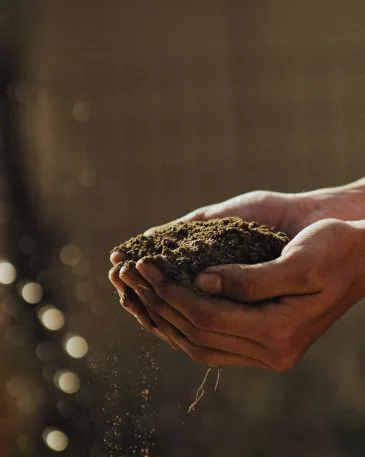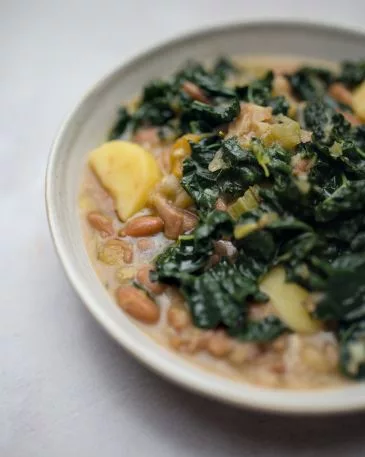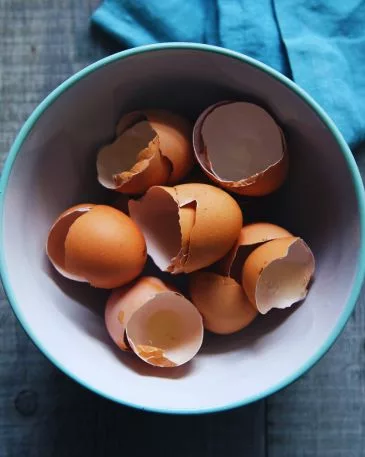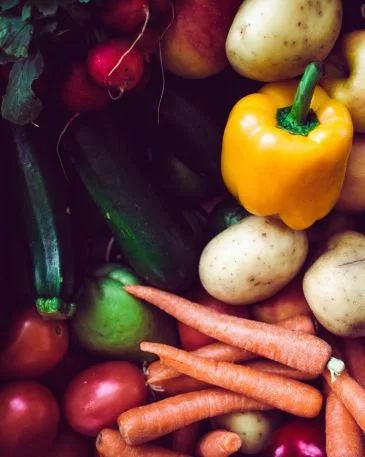Organic food is generally more expensive. How much more? It depends on the product and the brand, but typically anywhere between 10% and 300% the cost of non-organic produce. Averaging out at 75% more expensive. That’s nearly twice the price.
Organic food is, on average, 75% more expensive. – Kantar1
If you can afford this and want to make the change immediately, then that’s easy.
Many of us, though, especially in times of other high living costs, can’t afford to pay any more than we already are doing for the weekly shop. So is there anything we can do?
Luckily, yes there is. There are two main ways we can cut down the cost of the rest of our shop and free up some budget for buying more organic food. And as luck would have it, both of these ideas are climate-friendly too.
I also wanted to know what the cheapest way to buy organic food was. There’s a lot of myth, marketing and opinion on this subject, but not a lot of solid, proven advice on how to buy a healthy organic diet as cheaply as possible. In times like this, I want to know that I’m spending on the family food shop as wisely as possible. So I’ve looked at some different ways of buying organic food to find out how to do so most cost-effectively. I’ll take you through what I’ve discovered.
Why does organic food cost so much?
There are two reasons. Firstly, it costs more to produce organic food, and secondly, organic farmers can charge more and be better paid.
It’s harder to produce
Growing organic crops and rearing organic livestock costs more because organic methods are less intensive than currently prevailing conventional (non-organic) agriculture. Because organic requires a focus on growing without fertilisers and pesticides, improving animal welfare by specifying a minimum amount of grazing land per animal, and leaving more space for nature, a single farm can’t produce as much from the same investment.
Organic farmers can’t be single-mindedly focused on the quantity of food produced. They have a deliberately split focus. As well as growing food for humans, they are also investing in creating rich soils that support themselves better, without fertilisers and waste manure running off into rivers and killing off marine wildlife. They’re also maintaining soils that absorb and store carbon emissions to help combat climate change. They are also building and maintaining landscapes that allow nature to thrive alongside crops.

In short, they’re investing in a sustainable way of producing. They’re paying today to maintain the biodiversity and earth systems that keep Earth functioning in a way that will support human life for the rest of our lifetimes and beyond.
Organic is paying it forward
Conventional agriculture is focused on feeding as many people as possible in the way those people want to be fed. This has worked very well in the past, but we’re increasingly seeing how we can’t continue to grow our food in this way. It’s not sustainable. It’s contributing to pushing the Earth over the edge in many vital ways that will (and already do) mean that our planet won’t be able to sustain us indefinitely.
The usual ways of growing food and rearing animals very intensively are productive. But they ignore the harm that’s being done. That’s either someone else’s problem or one for our future selves. Carbon emissions, fertiliser and waste leakages are doing damage that we will need to pay to fix very soon. But this isn’t being fixed during the food production stage.
One of the most inefficient parts is the way a lot of meat is produced – beef in particular. Vast tracts of land – especially rainforest and untouched natural landscapes – are cleared just to grow soybeans that are transported all over the world to feed cattle. 43 kg of feed is needed to produce just 1 kg of beef2. The clearing of these natural forests turns ecosystems that absorb and store carbon into attentively farmed areas that emit carbon. This way of growing beef cattle is cheap and effective, but ultimately damaging. Organic farming instead lets cattle graze local land, has limits on how much other feed animals can be fed, and requires that it’s bought as close to home as possible.
When we buy conventional food in the shops or at restaurants, we’re paying for the food and assuming that any negative impacts will be sorted out without us paying for them in that moment. It’s like throwing a big party, but not paying for the cleaners to come in afterwards. Just walking away and leaving the mess. When we buy organic, we’re paying to prevent mess in the first place, and for a lot (not all) of the cleanup to be done as the party’s going on, so we’re (nearly) ready for the next party as soon as this one ends.
The true cost of food
Researchers have calculated how much we will end up paying to clean up after just the greenhouse gas emissions from food production. It puts the true price we’ll end up having to pay for conventional food one way or another up much closer to the cost of organic food. And that’s putting aside other negative impacts like reducing biodiversity and changing ecosystems, which are much more negatively impacted3.
Supporting farmers
Farmers are able to charge more for organic produce. Shoppers are willing to pay a premium. This might be hard to hear, but it means that the farmers are making a better living. It’s important to many of us to support our local and British farmers, and perhaps even abroad. Buying organic is often doing just this.
How to afford organic groceries
We’ll look at two ways you could choose to make space in your weekly food budget for organic foods by saving money on other parts of your food shop, and then jump into where to find the best value organic food.
1. Save on meat
Food and climate scientists tell us that in the future if we’re eating a sustainable diet, we’ll be eating less, but higher quality meat. This meat will be produced less intensively, raised more ethically, more healthily and grazed on land more than fed in pens. This meat could be lower in antibiotics and higher in the good stuff like omega-3. If you’re a fan of meat, don’t worry, I’m with you. So stick with me…
While high protein diets are in fashion and many of us find that if we replace carbs with protein we feel better, lose weight and control our blood sugar better the same could be said of diets where we instead replace an excess of carbs with fruit and veg – it isn’t the protein that’s helping here, it’s the move away from the boom and bust effects carbohydrates have on blood sugar.
The average Westerner eats more protein than our bodies need. We’re very lucky that our diets can be so rich compared with previous generations, but this comes with some downsides.
Higher meat consumption, especially more red meat, is associated with heart disease, diabetes, some cancers and a shorter lifespan4.
While we want to make sure we get enough protein in our meals, it’s also true we don’t have to get all our protein from meat. If we reduce the protein we eat to nearer what our bodies actually need, we can cut out some of the expensive meat and even, if we want to, replace it with some cheaper plant sources of protein like peas and beans, lentils or tofu.


Let’s take a look at how much money your household could save each week by cutting out just a proportion of meat in the weekly shop, while still getting plenty of healthy protein.
How much could you save if you cut out a few portions of meat each week?
Based on what meat we typically eat in an average week, there’s scope in your diet to cut out some of the most common meat choices:
| One person’s portion | Protein per portion | Saving for 2 people | Saving for 4 people |
|---|---|---|---|
| 1 chicken breast5 | 34.8g | £2.12 | £4.24 |
| 1 portion mince6 | 24.6g | £1.65 | £3.30 |
| 2 sausages7 | 15.3g | £1.12 | £2.23 |
| Total | 74.7g | £4.89 | £9.77 |
How much protein do you need?
The Reference Nutrient Intake (RNI) for protein for adults is 0.75 g protein per kg body weight per day. This equates to 56 g a day for men (weighing 75 kg) and 45 g a day for women (weighing 60 kg).8
This is the minimum protein the UK health authorities advise that we eat each day. Let’s compare this with how much protein we actually tend to eat9.
| Protein needed per day | Protein typically eaten per day | |
|---|---|---|
| Average woman | 45g | 76g |
| Average man | 56g | 76g |
We consume a lot more protein than our bodies actually need to be healthy.
Would you get enough protein if you saved money by reducing meat in your meals?
If you took out the three portions of meat mentioned above in a week, you’d reduce your protein intake in the week by 74.7g – that’s an average of 10.7g a day.
How would this stack up against what you need to be eating?
| | Protein needed per day | Protein typically eaten per day when cutting out 3 meat portions |
|---|---|---|
| Average woman | 45g | 65g |
| Average man | 56g | 65g |
That’s still plenty of protein. So you could go one step further and save more money by cutting out more meat, or even swapping some of it for plant-based protein options to keep your protein consumption about the minimums.
2. Save on wasted food
It pains me every time I have to throw something away because it’s gone off before I’ve served it up. But this is the most common reason food is wasted in our homes. The impact of this is huge – both on our finances…
Forgotten food costs the average household £800 a year10
…and on the planet. All that food was produced ready to be eaten, with all the water consumption, fertiliser use, plastic usage and carbon emissions it took to get it into our houses.
- 18% of what we spend on the weekly food shop is thrown away11
- 40 kg of food brought home is thrown away yearly1213
There’ll always be some food waste in your house from ‘inedible parts’ like bones, eggshells or peels. But these parts only make up a third of what’s actually in our food bins.14
The other two-thirds is avoidable. If we can reduce this inadvertent waste, we won’t have to buy as much each week. What are the best ways to do this?

Plan meals
Make a plan of what you’re going to eat each week before you do a weekly shop. I can’t deny the weekly food planning and shop takes up much longer than I’d like it to each week. But it’s worth it.
It lets you buy in bulk and plan meals that will use up similar ingredients while making sure that you’ve got a healthy diet overall. It means you won’t have to improvise Ready, Steady, Cook style with a load of random ingredients each night, inevitably leaving some out that just don’t go.
Buy online
Ordering groceries online comes with its own cost – a monthly subscription or a delivery fee. But you could save more than that by having time to consider cheaper options and check that their nutritional value is as good as a more expensive option while avoiding the temptation of impulse buys.
Keep track of use by dates
You’ve probably seen the campaigns telling you not just to bin food that’s past its best before date. That’s a great idea. If it has a best before date, it’s not food that becomes dangerous as soon as it gets old. You can give it an eye and a sniff and if it’s fresh, you can eat it.
But for foods with a use by date, you can’t be so cavalier about it without risking food poisoning. So keep track of when things go off. When we have the weekly shop in the house, I write down the key use by date for each meal on the meal plan and that tells us what we should be eating first.
Store it and use it up
If some food does reach the end of its life, keep space in your freezer to stick it in and bring it back out the following week. For food that doesn’t freeze well, having a few recipes up your sleeve for the kinds of food that usually get left in your house, like a salad or soup can save the day.
How much could you save each week by avoiding waste?
These are the average amount different UK households spend on food each week as of June 2023. If you could halve, quarter, or totally eliminate your avoidable food waste (leaving just the shells, peels, and bones), how much money could you potentially save?
The average family could save over £16 a week by eating or preserving everything before it goes off in the cupboard or the fridge.
| Household | Average weekly food shop | Average weekly spend wasted (18%) | Savings if you halve your edible food waste | Savings if you quarter your edible food waste | Savings if you zero your edible food waste |
|---|---|---|---|---|---|
| Young, active adult male | £51.70 | £6.51 | £3.26 | £4.89 | £6.51 |
| Average adult male | £41.90 | £5.28 | £4.65 | £3.96 | £5.28 |
| Young, active adult female | £47.90 | £6.04 | £4.65 | £4.53 | £6.04 |
| Average adult female | £31.90 | £4.02 | £4.65 | £3.01 | £4.02 |
| 2 adults (1 man + 1 woman) | £73.80 | £9.30 | £4.65 | £6.97 | £9.30 |
| 2 adults + 1 child | £101.50 | £12.79 | £4.65 | £9.59 | £12.79 |
| 2 adults + 2 children | £129.20 | £16.28 | £4.65 | £12.21 | £16.28 |
| 2 adults + 3 children | £156.80 | £19.76 | £4.65 | £14.82 | £19.76 |
3. Buy cheap organic food
Now you should have a rough idea of how much you could save each week. You could choose to pocket this difference, knowing that you’re already contributing to preventing climate change by reducing your meat consumption and wasting less.
But you’re here because you’d like to spend it on buying organic food. So how much could you buy with your savings?
Are veg boxes the cheapest way to buy organic veg?
In looking for the cheapest way to buy my family organic food, I read a lot of articles telling me that fruit and vegetable box subscriptions are the cheapest way to get organic produce. I wanted to test this out. So I compared the price of a fruit and veg box that would feed my family (serves 3-4 for a week) with what I’m currently paying for non-organic fruit and veg in the supermarket and the price of switching that all to organic supermarket produce.

It was over 80% more expensive to switch from conventional to organic at the supermarket. To buy that all in a weekly box subscription was marginally cheaper. For the 83 pence I’d be saving on a veg box, I decided that I’d be more likely to waste less from a supermarket shop where I get to choose the items and the quantities that I need that week, rather than having to plan meals around these boxes.
The main thing I’m not happy with about the supermarket organic produce though is that there’s little accountability or clarity about where in the world it’s from. It could be imported from further away than the conventional produce, and end up having a higher climate impact. The good thing about the box schemes is that they tend to have clear sourcing policies around buying British first, and you can even opt for seasonal boxes.
The box used in this example was from Riverford Organic Farmers. From surveying the market, it’s a typical price to pay for this quantity of predominantly British organic fruit and veg, so you could select from them or any of their competitors.
| Fruit & veg to feed 3-4 people for a week | Conventional cost | Organic cost | Organic box cost |
|---|---|---|---|
| Salad potatoes (1.2kg) | £1.44 | £2.00 | £27.55 |
| Spring onions (x1) | £0.50 | £1.00 | |
| Carrots (800g) | £0.40 | £1.26 | |
| Bunched golden beetroot (x1) | £2.00 | £2.89 | |
| Pointed cabbage (x1) | £0.65 | £2.25 | |
| Baby spinach (200g) | £1.23 | £4.33 | |
| Padron peppers (200g) | £1.93 | £2.85 | |
| Bunched radishes (x1) | £0.49 | £2.00 | |
| Apples (800g) | £3.08 | £4.55 | |
| Pears (800g) | £3.05 | £3.64 | |
| Bananas (800g) | £0.81 | £1.62 | |
| Extra you’re paying to go organic | £12.80 | £11.97 | |
| Cost | £15.58 | £28.38 | £27.55 |
| Extra you’re paying to go organic | – | £12.80 | £11.97 |
What have I done in the end?
After much searching, I eventually found a nearby farm with a vegetable box scheme for local collection. They’re not organic, but biodynamic (so yes, no certification and proof of a sustainable approach). But their boxes are £17 for a box for 3-4. I’ve had to top it up with bananas and apples to get to the same amount of fruit as a Riverford organic box, but it’s proving a winner in our house so far.
What can you do now?
You want to do the best thing to be sustainable or net zero with your household food, but it’s hard to know what that is. Discover how environmentally friendly organic food is.
You’ve no doubt heard a lot about how healthy organic food is. How fewer pesticides and chemicals will make you feel better and help you avoid disease. This isn’t the whole story. Find out the truth behind the myths of organic health claims.
Hero image credit: Photo by Raul Gonzalez Escobar on Unsplash. Gallery images: Victoria Shes on Unsplash, Green And Great on Unsplash, Gabriel Jimenez on Unsplash, CA Creative on Unsplash, Marisol Benitez on Unsplash.
Footnote – price comparison data, accessed 18 August 2023:
| Item to compare | Conventional cost calculated from | Supermarket organic cost calculated from | Organic box cost calculated from |
|---|---|---|---|
| Salad potatoes (1.2kg) | Tesco Baby Potatoes 1Kg, £1.20, https://www.tesco.com/groceries/en-GB/products/255095718 | Tesco Organic Baby Potatoes 750G, £1.20, https://www.tesco.com/groceries/en-GB/products/288043433 | https://www.riverford.co.uk/seasonal-organic-boxes/organic-fruit-and-veg-boxes |
| Spring onions (x1) | Tesco Bunched Spring Onions 100G, £0.50, https://www.tesco.com/groceries/en-GB/products/281035500 | Tesco Organic Spring Onions 100G, £1.00, https://www.tesco.com/groceries/en-GB/products/281056432 | |
| Carrots (800g) | Tesco Carrots Loose, £0.50/kg, https://www.tesco.com/groceries/en-GB/products/254638565 | Organic Carrots 700G, £1.10, https://www.tesco.com/groceries/en-GB/products/256687445 | |
| Bunched golden beetroot (x1) | Limited Selection Golden Beetroot 350g, £2.00, https://www.waitrose.com/ecom/products/limited-selection-golden-beetroot/581878-204839-204840 | Natoora Golden Beetroot 400g, £3.30, https://www.ocado.com/products/natoora-golden-beetroot-77612011 (not certified oragnic – from sustainable farms) | |
| Pointed cabbage (x1) | Tesco Sweet Heart Cabbage Each Class 1, £0.65, https://www.tesco.com/groceries/en-GB/products/254941983 | Pointed Cabbage, £2.25, https://www.riverford.co.uk/organic-fruit-veg-and-salad/vegetables/pointed-cabbage | |
| Baby spinach (200g) | Tesco Baby Spinach 220G, £1.35, https://www.tesco.com/groceries/en-GB/products/304401971 | Baby spinach 150g, £3.25, https://www.riverford.co.uk/organic-fruit-veg-and-salad/salad/baby-spinach | |
| Padron peppers (200g) | Sainsbury’s Padron Peppers, Taste the Difference 135g, £1.30, https://www.sainsburys.co.uk/gol-ui/product/sainsburys-padron-peppers | Padron Peppers 200g, £2.85, https://www.riverford.co.uk/organic-fruit-veg-and-salad/vegetables/peppers-padron | |
| Bunched radishes (x1) | Tesco Radish Pack 240g, £0.49, https://www.tesco.com/groceries/en-GB/products/261049366 | Duchy Organic Bunched Radish, £2.00, https://www.waitrose.com/ecom/products/duchy-organic-bunched-radish/835248-726596-726597 | |
| Apples (800g) | Large Pink Lady Apples Class 1 Loose, £3.85/kg, https://www.tesco.com/groceries/en-GB/products/251627289 | Tesco Organic Pink Lady Apples 440G, £2.50, https://www.tesco.com/groceries/en-GB/products/293171580 | |
| Pears (800g) | Tesco Ready To Eat Seasonal Pears 4Pack 550G, £2.10, https://www.tesco.com/groceries/en-GB/products/284475164 | Ocado Organic Ripe & Ready Pears 4 per pack, £2.50, https://www.ocado.com/products/ocado-organic-ripe-ready-pears-325613011 | |
| Bananas (800g) | Tesco Bananas Loose, £1.01/kg, https://www.tesco.com/groceries/en-GB/products/275280804 | Tesco Organic Fair Trade Bananas 5 Pack, £1.35, https://www.tesco.com/groceries/en-GB/products/303869954 |
Sources:
- Kantar, Bread & Jam, The Future Summit, 23rd May 2023↩
- David Pimentel, Marcia Pimentel, “Sustainability of meat-based and plant-based diets and the environment”, The American Journal of Clinical Nutrition, Volume 78, Issue 3, 2003, Pages 660S-663S, https://doi.org/10.1093/ajcn/78.3.660S↩
- Pieper, M., Michalke, A. & Gaugler, T. “Calculation of external climate costs for food highlights inadequate pricing of animal products.” Nat Commun 11, 6117 (2020). https://doi.org/10.1038/s41467-020-19474-6↩
- “Protein: What you need to know – Heart Matters magazine – BHF.” British Heart Foundation, https://www.bhf.org.uk/informationsupport/heart-matters-magazine/nutrition/protein. Accessed 1 September 2023.↩
- Tesco British Chicken Breast Portions 650G, £4.75,
145g per portion, https://www.tesco.com/groceries/en-GB/products/294007923↩ - Tesco Beef Steak Mince 500G 15% Fat, £3.30, 125g per portion,
https://www.tesco.com/groceries/en-GB/products/296422877↩ - Tesco 12 Pork Sausages 681G, £3.35, 2 sausages per portion,
https://www.tesco.com/groceries/en-GB/products/265236085↩ - British Nutrition Foundation. “Protein.” British Nutrition Foundation, https://www.nutrition.org.uk/healthy-sustainable-diets/protein/?level=Health%20professional. Accessed 1 September 2023.↩
- Stewart, Cristina, et al. “Trends in UK Meat Consumption: Analysis of Data From Years 1–11 (2008–09 to 2018–19) of the National Diet and Nutrition Survey Rolling Programme.” The Lancet Planetary Health, vol. 5, no. 10, Elsevier BV, Oct. 2021, pp. e699–708. Crossref, https://doi.org/10.1016/s2542-5196(21)00228-x.↩
- Tesco. “Forgotten food costing families approx. £800 a year.” Tesco PLC, 29 April 2022, https://www.tescoplc.com/forgotten-food-costing-families-approx-800-a-year/. Accessed 16 August 2023.↩
- Bawden, Tom. “Britons throwing away more than £500 of food a year despite cost of living crisis.” iNews, 21 April 2023, https://inews.co.uk/news/britons-throwing-away-food-cost-of-living-crisis-2290018. Accessed 16 August 2023.↩
- UN Environment Program. Food Waste Index Report, 2021. 2021, https://wedocs.unep.org/handle/20.500.11822/35280. Accessed 9 July 2023.↩
- ONS. “Household and resident characteristics, England and Wales: Census 2021.” Office for National Statistics, 2 November 2022, https://www.ons.gov.uk/peoplepopulationandcommunity/householdcharacteristics/homeinternetandsocialmediausage/bulletins/householdandresidentcharacteristicsenglandandwales/census2021. Accessed 29 July 2023.↩
- ONS. “A review of household behaviour in relation to food waste, recycling, energy use and air travel.” Office for National Statistics, 1 November 2021, https://www.ons.gov.uk/economy/environmentalaccounts/articles/areviewofhouseholdbehaviourinrelationtofoodwasterecyclingenergyuseandairtravel/2021-11-01. Accessed 16 August 2023.↩

